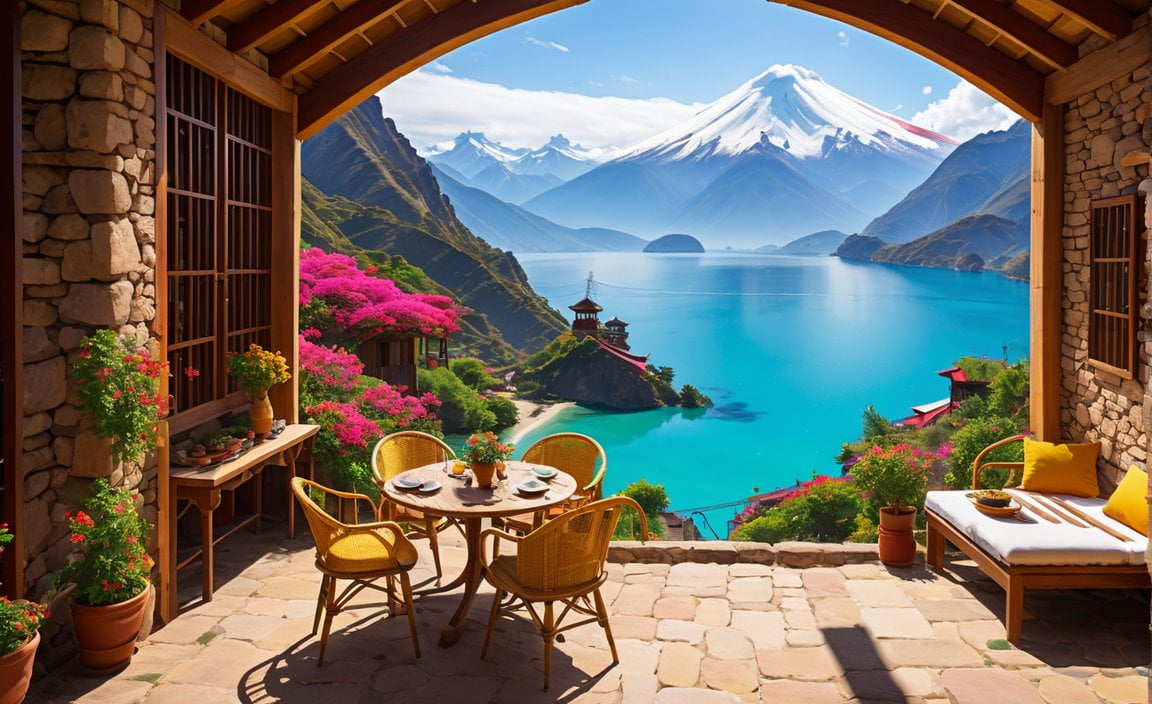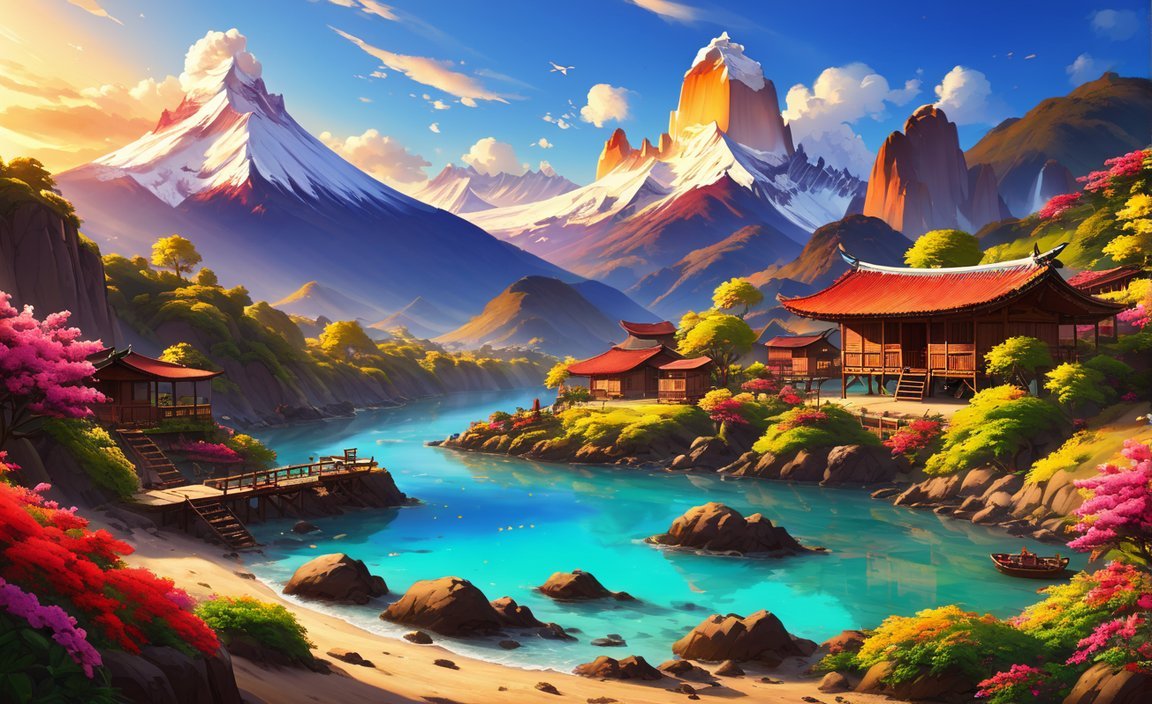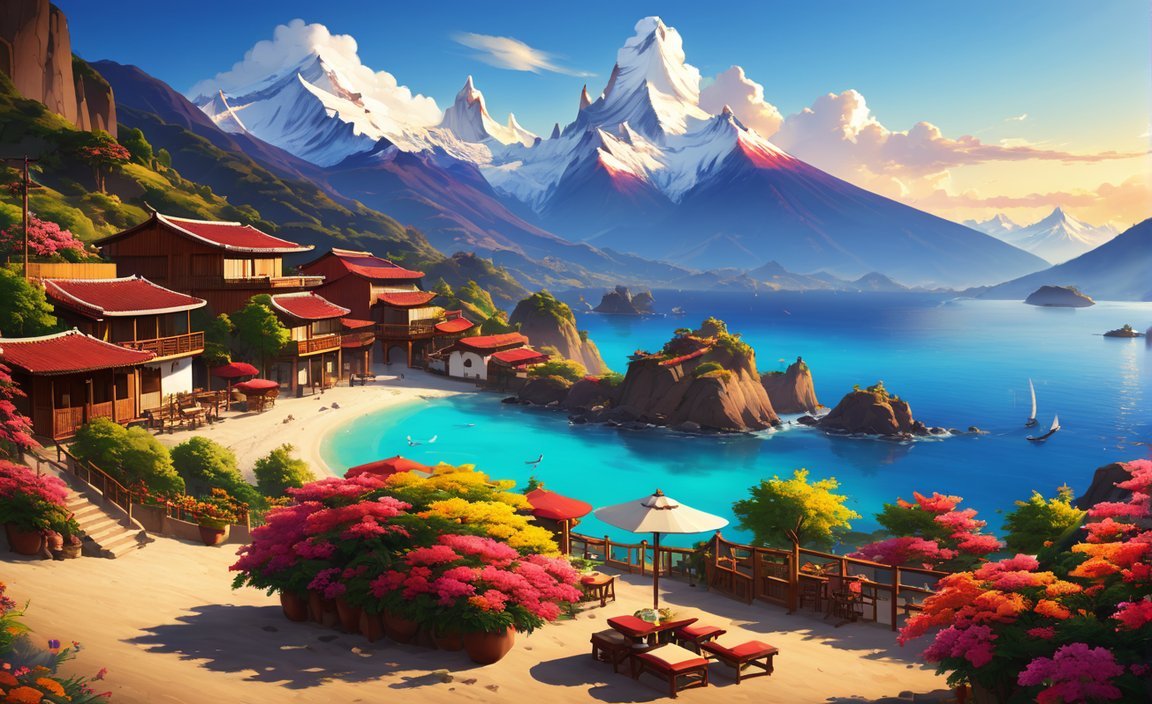Discover Chile: Unveiling Random Facts and Hidden Gems

Embark on a captivating journey to Chile, where an abundance of random facts and hidden gems await your exploration. From its breathtaking landscapes to its vibrant cultural heritage, this South American gem is a treasure trove for avid travelers and cultural enthusiasts alike. Brace yourself for a whirlwind of intriguing historical details, geographical wonders, and fascinating cultural tidbits that will leave you spellbound. With every turn, Chile unveils its unique charm and enthralling secrets, taking you on an unforgettable adventure like no other. So, prepare to expand your horizons and delve into the mesmerizing world of Chile’s random facts and hidden gems.
Key Takeaways:
- Chile is the longest country in the world, stretching 2,653 miles from north to south.
- The Andes Mountain Range runs the entire length of Chile.
- The Atacama Desert in Chile is the largest dry desert in the world.
- Easter Island in Chile is the most remote inhabited island on Earth.
- Chile’s coastal city of Algarrobo is home to the world’s largest swimming pool.
- Chile has a government-supported UFO research organization.
- Chile boasts one of the longest coastlines in the world.
- Chile’s climate ranges from desert in the north to temperate rainforest in the south.
- The Easter Island statues, known as Moai, are famous landmarks in Chile.
- Chile is a major producer of copper, wine, fruit, seafood, and renewable energy.
- Chile has a rich history of indigenous cultures, including the Mapuche and the Rapa Nui.
- Notable cultural figures from Chile include Nobel Prize-winning poets Pablo Neruda and Gabriela Mistral.
- Empanadas are the national dish of Chile.
- Santiago is the capital city of Chile.
Random Facts About Chile
Chile: Land of Wonders and Surprises
Chile, the longest country in the world from north to south, spanning an impressive 2,653 miles, is a land of wonders and surprises. Its diverse landscapes, rich heritage, and intriguing culture make it a captivating destination for those seeking extraordinary experiences. Embark on a journey through Chile’s hidden gems as we uncover some fascinating random facts that make this country truly unique.
The Majestic Andes Mountain Range
Stretching across the entire length of Chile is the majestic Andes Mountain Range. This towering natural wonder stands as a breathtaking backdrop, providing a dramatic and awe-inspiring landscape. From snow-capped peaks to lush valleys, the Andes offer a picturesque view at every turn.
The Enigmatic Atacama Desert
Prepare to be amazed by the largest dry desert in the world, the Atacama Desert, found in Chile. This otherworldly expanse of arid terrain boasts landscapes reminiscent of Mars, with its vast salt flats, lunar-like dunes, and bubbling geysers. Explore this extraordinary desert and immerse yourself in its surreal charm.
Easter Island: A Remote Paradise
Hidden in the vastness of the Pacific Ocean, Chile is home to the most remote inhabited island in the world—Easter Island. Famous for its enigmatic Moai statues, this isolated paradise offers a glimpse into an ancient civilization that continues to intrigue and mystify travelers from around the globe.
Dive into the World’s Largest Swimming Pool
Located in the coastal city of Algarrobo, Chile proudly boasts the title of having the world’s biggest swimming pool. Spanning an impressive 20 acres, this crystal-clear pool invites visitors to soak up the sun, enjoy refreshing dips, and revel in the sheer bliss of its sheer size.
Uncover the Extraterrestrial
Did you know that Chile has a government-supported UFO research organization? Yes, that’s right! Open your mind to the mysteries of the universe as you delve into Chile’s fascination with unidentified flying objects. Whether you’re a skeptic or a believer, this intriguing aspect of Chile’s culture is sure to spark your curiosity.
Endless Coastlines and Coastal Charms
Chile is celebrated for having one of the longest coastlines in the world. Explore its pristine sandy beaches, hidden coves, and charming seaside towns. From bustling city beaches to untouched natural wonders, the Chilean coast offers a diverse range of coastal delights for every traveler to enjoy.
A Climate of Contrasts
From the arid deserts in the north to the temperate rainforests in the south, Chile’s climate is a true testament to the country’s geographical diversity. Experience the extremes as you journey through vast expanses of desert and lose yourself in lush forests. Chile’s climate promises a captivating adventure filled with contrasting landscapes and stunning natural beauty.
Cultural Heritage and Notable Figures
Chile proudly carries a rich history of indigenous cultures, such as the Mapuche and the Rapa Nui. These ancient civilizations have left their mark on Chile’s cultural tapestry, providing a fascinating glimpse into the past. Additionally, Chile’s cultural heritage extends beyond ancient roots, with notable figures like Nobel Prize-winning poets Pablo Neruda and Gabriela Mistral, who have left an indelible legacy on the literary world.
Culinary Delights and National Pride
No exploration of Chile is complete without savoring its gastronomic wonders. The national dish of Chile, empanadas, showcases the country’s culinary prowess. Indulge in these mouthwatering pastries, filled with a variety of delectable ingredients, as you immerse yourself in Chilean cuisine. From savory to sweet, the flavors of Chile are sure to leave your taste buds yearning for more.
Journey Into the Heart of Chile
As you make your way through the vibrant streets, historical landmarks, and breathtaking landscapes of Chile, the capital city, Santiago, stands as a cultural hub. Discover the city’s vibrant energy, vibrant markets, and impressive architecture. Santiago is a gateway to Chile’s wonders, connecting travelers to the heart and soul of this captivating country.
So, pack your bags and embark on an adventure like no other. Chile’s random facts and hidden gems await, promising to immerse you in a world of natural wonders, fascinating culture, and breathtaking experiences. Get ready to uncover the treasures of this captivating country and create memories that will last a lifetime.
- What is the state of Michigan known for – Did you know that Michigan is famous for its stunning Great Lakes, vibrant automotive industry, and historic Motown sound?
- What is the highest point in Arkansas – Explore the breathtaking beauty of Arkansas by discovering its highest point, Mount Magazine, where you can witness mesmerizing panoramic views.
- Fun facts Hoover Dam – Dive into the fascinating world of engineering with these intriguing facts about the iconic Hoover Dam, from its colossal size to its impressive electricity production.
- Longest volleyball game – Find out about the intense battle that took place in the longest volleyball game ever recorded, with thrilling rallies that lasted for an astonishing length of time.
- Where is volleyball most popular – Discover the countries where volleyball reigns supreme, from its birthplace in the United States to its soaring popularity in Brazil, Italy, and Russia.
- How many capitals has Honduras had – Learn about the rich history of Honduras with its intriguing past, which includes multiple capital cities throughout the years.
- List of counties in the United States – Embark on a journey through the diverse geography of the United States by exploring the extensive list of counties, each with its own unique characteristics.
The Magnificent Moai: Exploring the Enigmatic Statues of Easter Island
The Enigmatic Moai
- The Moai statues of Easter Island are truly awe-inspiring.
- With an average height of around 4 meters (some reaching up to 9 meters) and weighing approximately 12.5 tonnes, these colossal stone figures exhibit the incredible craftsmanship and dedication of the Rapa Nui people.
Creation and Purpose
- The Moai statues were crafted by the native inhabitants of Easter Island, the Rapa Nui people.
- They meticulously carved these statues from volcanic stone between the years 1400 and 1650 A.D.
- The purpose of the statues remains a topic of debate among researchers, but it is widely believed that they were created to honor ancestors or important figures in Rapa Nui society.
Unveiling the Mystery
- Easter Island and its Moai statues have long intrigued scholars and adventurers, sparking various theories and speculations about their origin and purpose.
- The isolation of the island in the southeastern Pacific Ocean adds to the enigma surrounding these statues.
- Many questions about the construction techniques, transportation methods, and cultural context of the Moai statues still remain unanswered.
- However, ongoing research and investigation shed new light on the fascinating history of Easter Island and its remarkable statues.
Cultural Significance
- The Moai statues hold immense cultural significance for the Rapa Nui people.
- These statues represent the artistic and architectural achievements of their ancestors and serve as a testament to their rich cultural heritage.
- The statues not only symbolize power and prestige but also embody the spiritual connection between the Rapa Nui people and their ancestors.
Preservation and Restoration Efforts
- Over time, some of the Moai statues have fallen, been damaged, or suffered wear and tear due to natural factors and human activities.
- However, dedicated conservation efforts have been made to preserve and restore these iconic statues.
- Restoration projects have been carried out on the island to ensure the survival and protection of the Moai for future generations.
Visiting the Island
- For those intrigued by the ancient wonders of Easter Island, visiting this remote Chilean territory is a must.
- The island offers a unique opportunity to witness the magnificence of the Moai statues in person.
- Exploring the archaeological sites and immersing oneself in the rich cultural history of the Rapa Nui people is an unforgettable experience.
Key Takeaways:
- The Moai statues of Easter Island are massive stone figures that were crafted by the Rapa Nui people between 1400 and 1650 A.D.
- The purpose of the Moai statues remains a topic of debate, but they are believed to have been built to honor ancestors or important figures in Rapa Nui society.
- Easter Island’s isolation and the mysteries surrounding the construction and transportation of the statues have intrigued researchers for centuries.
- The Moai statues hold immense cultural significance and symbolize the artistic and architectural achievements of the Rapa Nui people.
- Ongoing preservation and restoration efforts are in place to protect the Moai statues from natural damage and human activities.
- Visiting Easter Island allows visitors to witness the majesty of the Moai statues firsthand and explore the rich cultural history of the Rapa Nui people.
References:
- Tribes Travel. “The Moai statues of Easter Island, Chile.” source
- Easter Island Travel. “Easter Island: Moai statues.” source
Unveiling Random Facts about Chile: Chile Claims Sovereignty over a Vast Portion of Antarctica
Chile, a land of awe-inspiring landscapes and rich cultural heritage, unveils yet another remarkable fact that sets it apart from the rest. Amongst its many treasures lies the astonishing claim of sovereignty over a vast portion of Antarctica. As we dive deep into Chile’s intriguing history and geographical considerations, we discover the fascinating story behind this remarkable assertion.
Chile’s Spanish Heritage and Historical Rights
To understand Chile’s claim to Antarctica, we must trace back its roots to the time when it was a Spanish colony. The Spanish Crown, which had a considerable interest in exploring new territories, granted Pedro Sánchez de la Hoz a governorship in 1539. This governorship encompassed all lands south of the Straits of Magellan, potentially including the entirety of Antarctica. These Spanish claims on Antarctica were later inherited by Chile and Argentina, the two nations that emerged from these Spanish colonies.
Incorporating the Antarctic Peninsula
Chile’s expansion into Antarctica wasn’t a sudden event but rather a gradual process. The Antarctic Peninsula, a significant part of the continent, found its place within Chilean territorial boundaries before Chile formally claimed a sector between 53°W and 90°W in 1940. This expansion increased Chile’s surface area but also resulted in overlapping claims with other countries, such as the United Kingdom and Argentina.
The Impact of Constitutional Processes
Chile’s claims and sovereignty over Antarctica have not been without challenges. In 2022, a national referendum in Chile rejected the initial draft of a new constitution, consequently affecting the country’s claims and sovereignty over Antarctica. The lack of consensus compelled the government to embark on a second draft, indicating how constitutional processes can shape and influence territorial claims.
The Chilean Antarctic Territory
The Chilean Antarctic Territory stands as a testament to Chile’s unwavering sovereignty over a significant portion of Antarctica. While the signing of the Antarctic Treaty of 1959 limits certain aspects of Chile’s territorial claims, the Chilean Antarctic Territory remains under Chilean sovereignty. This territory reflects the historical, legal, and geographical considerations that bolster Chile’s assertion of authority in the icy expanse of Antarctica.
Influence of Historical Events and Overlapping Claims
Chile’s claims over Antarctica have not been unchallenged. Overlapping claims with countries like Argentina and the United Kingdom have sparked debates and discussions surrounding territorial rights. Despite these complexities, Chile continues to assert its claims based on historical and legal foundations inherited from its Spanish colonial past. The enduring influence of historical events shapes the landscape of Chile’s sovereignty over a vast portion of Antarctica.
Key Takeaways:
- Chile claims sovereignty over a substantial portion of Antarctica, which is rooted in its historical rights as a Spanish colony.
- The incorporation of the Antarctic Peninsula and subsequent territorial expansion contributed to Chile’s claim in Antarctica.
- Constitutional processes, such as national referendums, can impact Chile’s claims and sovereignty over Antarctica.
- The Chilean Antarctic Territory remains under Chilean sovereignty, with certain limitations defined by the Antarctic Treaty of 1959.
- Overlapping claims with countries like Argentina and the United Kingdom have shaped the complexities surrounding Chile’s assertions in Antarctica.
Source 1
Source 2
The Andes Mountains: Chile’s Impressive Landscapes and Outdoor Adventure Opportunities
The Andes Mountains run the entire length of Chile, providing impressive landscapes and outdoor adventure opportunities. This majestic mountain system, known as Cordillera de los Andes or Los Andes in Spanish, stretches along the western coast of South America, spanning approximately 4,500 miles from north to south.
Physical Features of the Andes Mountains
The Andes Mountains consist of a vast series of extremely high plateaus surmounted by even higher peaks, forming an unbroken rampart throughout their length [^1^]. Chile is fortunate to be blessed with the magnificent Chilean Andes, which run almost the entire length of the country, also forming a significant portion of Chile’s border with Argentina [^5^]. The Chilean Andes offer breathtakingly beautiful vistas, showcasing steep slopes, snow-capped mountains, and deep valleys [^5^]. These unique physical features contribute to the impressive landscape that captivates adventurers and nature enthusiasts.
Geographical Wonders of the Andes Mountains
The Andes Mountains present a diverse range of geographical wonders that make it a playground for outdoor adventurers. Peaks, glaciers, and volcanoes dot the landscape, creating a stunning backdrop for exploration [^7^]. With its wide-ranging North to South subdivisions, including the Southern Andes in Argentina and Chile, the Central Andes in Peru and Bolivia, and the Northern Andes in Venezuela, Colombia, and Ecuador, the Andes Mountains offer an array of adventure opportunities for travelers [^2^].
Outdoor Adventure Opportunities
With its rugged terrain and impressive landscapes, the Andes Mountains in Chile provide countless opportunities for outdoor enthusiasts. Artisanal trekking, mountaineering, and rock climbing are popular activities for those seeking a thrilling challenge. Hiking through the Andean foothills reveals breathtaking views and a sense of awe at the grandeur of nature [^5^].
For those seeking an adrenaline rush, white-water rafting in the Andes’ mighty rivers is an exhilarating experience. The rushing waters of the mountainous streams will test your skills and leave you with lasting memories [^5^].
Furthermore, the Andes Mountains offer the perfect setting for skiing and snowboarding during the winter months. Ski resorts such as Portillo, Valle Nevado, and Nevados de Chillan provide world-class slopes and facilities for both beginners and experts alike [^5^].
Key Takeaways:
- The Andes Mountains, stretching along the western coast of South America, run the entire length of Chile, offering impressive landscapes and outdoor adventure opportunities.
- Chile’s Andes feature steep slopes, snow-capped peaks, and deep valleys, making it a visual delight for nature enthusiasts.
- Peaks, glaciers, and volcanoes dot the Andes Mountains, contributing to its geographical wonders.
- The Andes provide a wide range of adventure opportunities, including trekking, mountaineering, rock climbing, white-water rafting, and skiing.
Sources:
1. Britannica – Andes Mountains
2. Wikipedia – Andes

FAQ
Q1: What is the longest country in the world from north to south?
A1: Chile is the longest country in the world from north to south, spanning 2,653 miles. [^1^]
Q2: What is the largest dry desert in the world?
A2: Chile is home to the largest dry desert in the world, the Atacama Desert. [^2^]
Q3: Where is the most remote inhabited island in the world located?
A3: The most remote inhabited island in the world, Easter Island, is located in Chile. [^2^]
Q4: What is the largest swimming pool in the world and where is it located?
A4: Chile is home to the world’s largest swimming pool, located in the coastal city of Algarrobo. [^3^]
Q5: What are some famous landmarks in Chile?
A5: Some famous landmarks in Chile include the Easter Island statues, known as Moai, and the capital city of Santiago. [^1^] [^11^]
- Who Owns Mercedes Cars? 2025 Update: Unveiling the Shareholders - May 6, 2025
- UAE Federal National Council: Evolution of Participation - May 6, 2025
- Trump’s 2025 Portrait: Unveiled, Analyzed - May 6, 2025
















